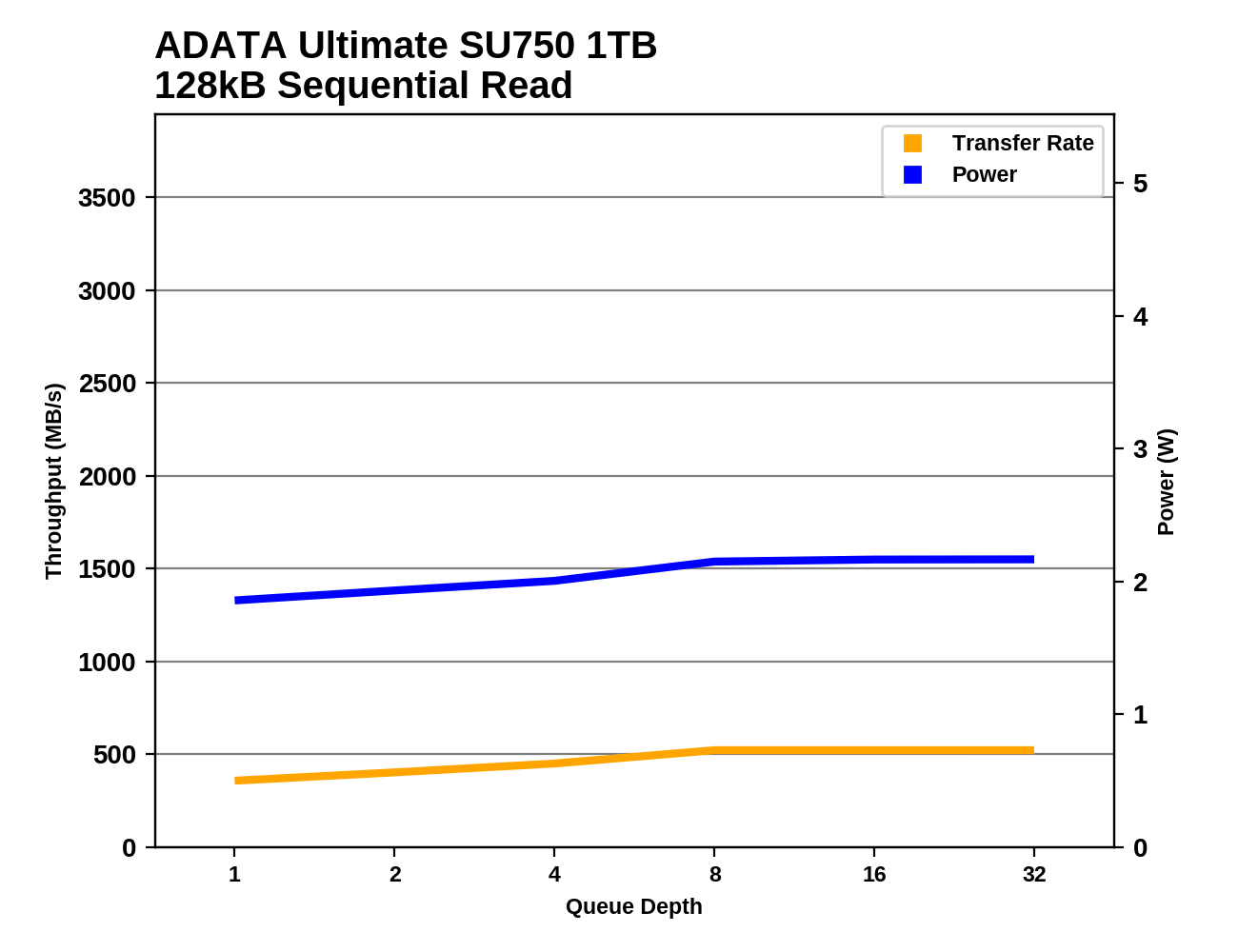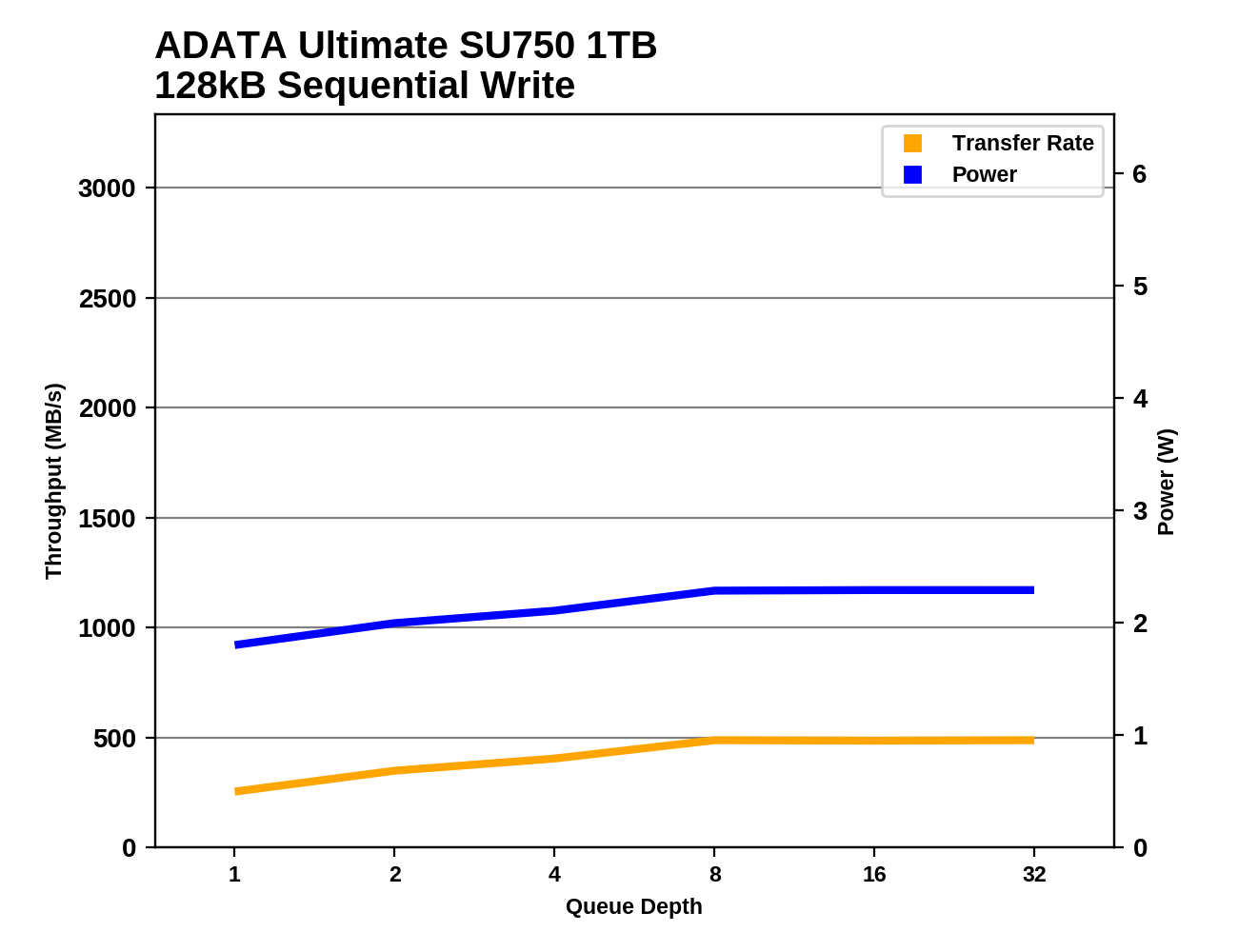The ADATA Ultimate SU750 1TB SSD Review: Realtek Does Storage, Part 1
by Billy Tallis on December 6, 2019 8:00 AM ESTSequential Read Performance
Our first test of sequential read performance uses short bursts of 128MB, issued as 128kB operations with no queuing. The test averages performance across eight bursts for a total of 1GB of data transferred from a drive containing 16GB of data. Between each burst the drive is given enough idle time to keep the overall duty cycle at 20%.

The burst sequential read performance from the ADATA Ultimate SU750 is a little bit slower than the mainstream SATA drives, but it's ahead of the other two entry-level drives.
Our test of sustained sequential reads uses queue depths from 1 to 32, with the performance and power scores computed as the average of QD1, QD2 and QD4. Each queue depth is tested for up to one minute or 32GB transferred, from a drive containing 64GB of data. This test is run twice: once with the drive prepared by sequentially writing the test data, and again after the random write test has mixed things up, causing fragmentation inside the SSD that isn't visible to the OS. These two scores represent the two extremes of how the drive would perform under real-world usage, where wear leveling and modifications to some existing data will create some internal fragmentation that degrades performance, but usually not to the extent shown here.

On the longer sequential read test, the SU750 is in last place and about 15% slower than the 860 QVO, though when reading back data that was written out of order, the 860 QVO is worse. The DRAMless Toshiba TR200 does well in both cases.
 |
|||||||||
| Power Efficiency in MB/s/W | Average Power in W | ||||||||
The power efficiency scores from the SU750 are again among the lowest, but unlike the random IO tests it isn't a big outlier in terms of either efficiency or total power draw.
 |
|||||||||
The SU750 does eventually reach sequential read speeds that more or less saturate the SATA link, but it requires a higher queue depth than any of the other drives in this batch. Power consumption is consistently just a bit higher than typical for mainstream drives, so at high queue depths its efficiency scores wouldn't be as bad as the low-QD scores shown above.
The SU750's sequential read speed at QD1 is definitely one of the slowest results we've seen, but at higher queue depths it is adequately fast and its power consumption is merely above-average and doesn't stand out from the crowd.
Sequential Write Performance
Our test of sequential write burst performance is structured identically to the sequential read burst performance test save for the direction of the data transfer. Each burst writes 128MB as 128kB operations issued at QD1, for a total of 1GB of data written to a drive containing 16GB of data.

The burst sequential write performance of the SU750 is clearly slower than mainstream SATA drives, but is nowhere near as bad as the Toshiba TR200's sub-HDD result.
Our test of sustained sequential writes is structured identically to our sustained sequential read test, save for the direction of the data transfers. Queue depths range from 1 to 32 and each queue depth is tested for up to one minute or 32GB, followed by up to one minute of idle time for the drive to cool off and perform garbage collection. The test is confined to a 64GB span of the drive.

On the longer sequential write test that brings in some higher queue depths, the SU750 falls a little further behind the mainstream SATA drives, and the Samsung 860 QVO crashes down to last place while the Toshiba TR200 starts to catch up with the SU750.
 |
|||||||||
| Power Efficiency in MB/s/W | Average Power in W | ||||||||
The power efficiency score for the SU750 during the sequential write test is not bad, for a change. The absolute power consumption is lower than most of the other drives, and the performance is good enough to make for decent efficiency.
 |
|||||||||
As with the sequential read test, the SU750 needs a fairly high queue depth to reach its full sequential write performance, which is competitive with mainstream SATA drives. It retains that performance for the rest of the test.
The low-QD sequential write performance from the SU750 could certainly be a lot worse, judging by some of the results from our archive. Across its entire speed range, the power consumption of the SU750 seems to be a bit below average, but never low enough to translate into impressive efficiency.












54 Comments
View All Comments
brucethemoose - Friday, December 6, 2019 - link
Depends how much you write. An HDD is great stone cold or hot bulk data, but I'd trust a big, cheapo SSD more for my "lukewarm" stuff, where I'm reading it every once in awhile, but not writing enough to wear the QLC out.flyingpants265 - Friday, December 6, 2019 - link
For stuff I actually don't want to lose, which is not that much (200gb or so), I have it on SSD, HDD, and another offline HDD which is unplugged.TheinsanegamerN - Sunday, December 8, 2019 - link
Your average SSD user will reach the TBW rating in 56 years of daily use. "lifespan" isnt an issue. If you ARE regularly writing terrabytes of data, the sheer speed difference of a SSD will save you truckloads of time/money.HDDs suck outside of niche massive file allocation.
FunBunny2 - Sunday, December 8, 2019 - link
"HDDs suck outside of niche massive file allocation. "and data stability.
extide - Friday, December 6, 2019 - link
Samsung 860 QVO 4TBflyingpants265 - Friday, December 6, 2019 - link
Not a bad idea, but I couldn't justify $300+ for a 4TB SSD.I think my ideal setup right now is still 1TB nvme+a few hard drives..
romrunning - Friday, December 6, 2019 - link
The Crucial MX500 2TB goes for $206-220 on Amazon. It's also a decent performer.PaulHoule - Friday, December 6, 2019 - link
I get depressed reading reviews of DRAMless SSDs. It seems like some vendors won't stop until they make an SSD which performs worse than an HDD.In general I don't agree with the rankings that Anand and other review sites give for SSDs. I don't particularly care about median performance, but I do care about performance at the 90%, 99%, etc. level -- because that is what causes your computer to freeze up for 10 seconds here or there.
Often reviewers pick out a drive that has good 50% performance, but for just a few dollars more you can get something with much better tail latency, for instance I have been happy with some Intel SSDs I've bought. If an "Intel Inside" sticker meant that a machine had an Intel SSD that would be impressive, but Intel has been damaging its brand with Atom, Celeron and things like that. They ought to take a cue from American car makers who regularly retire the names of the bad compact cars they make like Chevette, Gremlin, Neon, Cavalier, etc...
extide - Friday, December 6, 2019 - link
Yeah, I think Allyn at PCPer did the best SSD reviews tbh. He captures all of that 'last percent drop off' stuff you are talking about really well.Joahua - Saturday, December 7, 2019 - link
What is the use of Dram in ssd?Can i install dram less ssd for boot drive